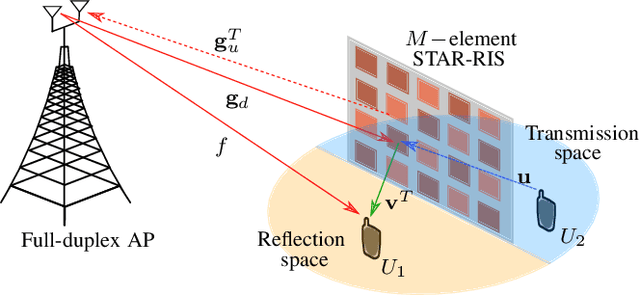Dhanushka Kudathanthirige
Sum Rate Maximization in STAR-RIS Assisted Full-Duplex Communication Systems
Mar 09, 2022


Abstract:The sum-rate performance of simultaneous transmitting and reflecting reconfigurable intelligent surface (STAR-RIS) assisted full-duplex (FD) communication systems is investigated. The reflection and transmission coefficients of STAR-RIS elements are optimized for the energy splitting and mode switching protocols to maximize the weighted sum rate of the system. The underlying optimization problems are non-convex, and hence, the successive convex approximation technique has been employed to develop efficient algorithms to obtain sub-optimal solutions. Thereby, the maximum average weighted sum rate and corresponding coefficients at the STAR-RIS subject to predefined threshold rates and unit-modulus constraints are quantified. The performance of the proposed system design is compared with the conventional reflecting/transmitting-only RISs and half-duplex counterparts via simulations where it is observed that STAR-RIS can boost the performance of FD systems.
Performance Analysis of IRS-Assisted Cell-Free Communication
Sep 26, 2021



Abstract:In this paper, the feasibility of adopting an intelligent reflective surface (IRS) in a cell-free wireless communication system is studied. The received signal-to-noise ratio (SNR) for this IRS-enabled cell-free set-up is optimized by adjusting phase-shifts of the passive reflective elements. Then, tight approximations for the probability density function and the cumulative distribution function for this optimal SNR are derived for Rayleigh fading. To investigate the performance of this system model, tight bounds/approximations for the achievable rate and outage probability are derived in closed form. The impact of discrete phase-shifts is modeled, and the corresponding detrimental effects are investigated by deriving an upper bound for the achievable rate in the presence of phase-shift quantization errors. Monte-Carlo simulations are used to validate our statistical characterization of the optimal SNR, and the corresponding analysis is used to investigate the performance gains of the proposed system model. We reveal that IRS-assisted communications can boost the performance of cell-free wireless architectures.
 Add to Chrome
Add to Chrome Add to Firefox
Add to Firefox Add to Edge
Add to Edge